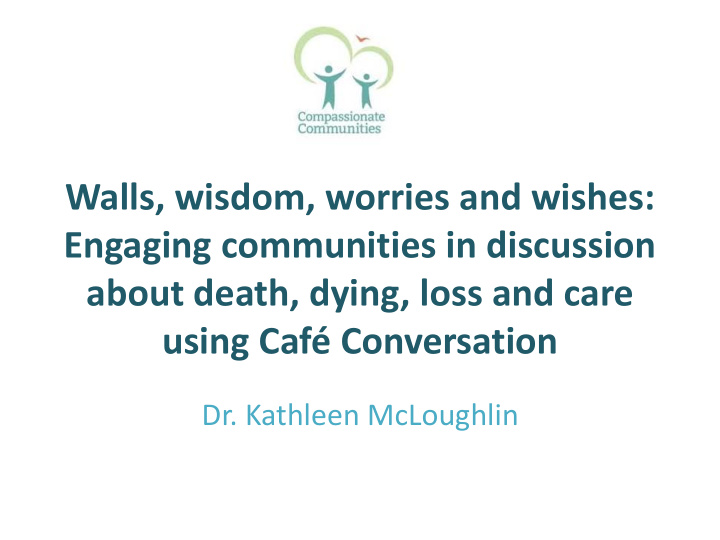



Walls, wisdom, worries and wishes: Engaging communities in discussion about death, dying, loss and care using Café Conversation Dr. Kathleen McLoughlin
So…it’s a Death Café?
The World Café – 7 Design Principles • Setting the context • Creating a hospitable space • Exploring questions that matter • Encouraging everyone’s contribution • Connecting diverse perspectives • Listening together • Sharing collective discoveries
Early experience • Average 10 participants • No set theme ‘a lovely gentle introduction to the subject of death. ’ ‘hard, they need to be themed so people have a real focus, the general approach doesn’t really work, people need to be guided’
(1) Advertising Café Conversations as something tangible (2) Raising awareness of the events through the media (3) Organizing events via existing community structures thereby reducing workload for the CCP and maximizing attendance.
Aim To create a safe, shared space to enable participants to understand the importance of thinking and talking about death, dying, loss, and care.
Objectives • to promote awareness and understanding of the CCP • AND why it is important to think and talk about illness, death, dying, and bereavement • to introduce people to the ‘language’ in which to have a conversation • to share appropriate resources to help people engage in difficult conversations and advance planning • to evaluate the impact and process.
Organisation • 2.5 hours – but a full days work! • Often held in the evening • Lots of advertising • Local champion
Creating a hospitable space
FILM 4
Exploring questions that matter • Why is it difficult to talk about death, dying, loss and care? What could make it easier? • Why is Thinking Ahead important? • What kind of things would you need to consider if you were Thinking Ahead – ? Who would you talk to?
Encouraging participation Ingredients of a successful conversation • Safe space • Confidentiality • Stay with the question • Listen respectfully • Laughter and tears • Turn off mobiles • One voice
Connecting diverse perspectives • movement between tables reduces the time available for engagement; • difficult for older people and those with disabilities; • the subject matter is sensitive. It takes time for people to share their experience, they need to build up trust with the fellow participants, and many discussions build on intimate knowledge shared in previous questions;
Listening together • Barriers – Emotional subject • Wisdom – Experience e.g. information about body donation • Worries – To die in pain • Wishes – To die at home
Sharing Collective Discoveries • Wooden coffin with lots of brass OR wicker casket? • Hymns OR favourite song at your funeral • Donate organs – Yes or No • Preferred place of death – home, nursing home, hospice, hospital, or somewhere else? • Donate your body to medical science – Yes or No • Burial or cremation? • Have someone with you at the time of diagnosis? • Who gets the dog?
Resources
Evaluation • Optional pre and post-session anonymous questionnaires • Basic demographic information; • Open-ended questions to determine people’s motivation for attending and suggested • improvements; • Series of four questions with Likert scale responses (1 – 5) developed to measure changes in knowledge and attitude
Responders • 69% (51/74) • 84% female • 34-88 years (M=55.6, SD=12.6) • Wanted to learn more • Had a recent bereavement • 100% would recommend it to a friend
5 4 3 Pre Post 2 1 0 Understand the importance of Understanding of Milford Understanding of CCP Difficulty talking about these issues talking about these issues
Key Learning • Important outreach to engage people in project and other elements of CCP • Interactive resource bank • Skilled facilitators • Recent bereavement / hidden losses • Invigorating events • Local support – tables support themselves • Participants are problem solvers…for others • Observed male and female differences • Importance of partnerships
Recommend
More recommend